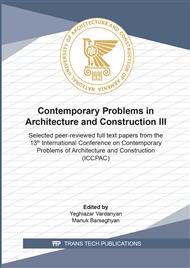[1]
M.M. Badalyan, Development of multifunctional building materials based on volcanics. Abstract of doctoral dissertation, Yerevan, (2009).
Google Scholar
[2]
N.A. Eroshkina, M.O. Korovkin, E.I. Tymchuk,Prospectsforthedevelopmentof alkaline activation binders. Electronic scientific and practical journal Modern scientific research and innovation,, Penza, 2015 (in russian).
Google Scholar
[3]
Glukhovsky V.D. Concrete of the past, present and future. Slag-alkali cements, concretes and structures,, v.1, Kiev, 1989, pp.7-15.
Google Scholar
[4]
Krivenko P.V., Ryabova A.G., Slag-alkali binders based on slag from thermal power-stations. Slag-alkali cements, concretes and structures,, v.1, Kiev, 1989, pp.181-183.
DOI: 10.4324/9780203390672_chapter_4
Google Scholar
[5]
Israelyan V.R., Abueva Z.A., Bagdasaryan L.B. Physicochemical characteristics of the behavior of aggregates of volcanic origin in concrete. Yerevan, Hayastan,. 1986. p.110.
Google Scholar
[6]
M.G. Badalyan, V.M. Arzumanyan, M.M. Badalyan, P.A. Ter-Petrosyan, Investigation of the strength characteristics of a binderbased on calcareous-volcanogenicaluminosilicaterocks. Sat. Proceedings of Arm NIIIStroyindustriya. (1992) 63-66.
Google Scholar
[7]
M.G. Badalyan, J.M. Astvatsatryan, L.G. Kalashyan, M.M. Badalyan, P.A. Ter-Petrosyan, Binders for cement less concrete. Sat. Proceedings ofArmNIIIStroyindustriya.(1992) 61-66.
Google Scholar
[8]
Davidovits J. Geopolymer chemistry and applications. 5rd eddition. –France,Saint-Quentin: Institute Geopolymer, 2020. – 674 p.
Google Scholar
[9]
Alkali activated materials: State-of-the-Art Report / ed. by J.L. Provis, J.S.J. van Deventer // RILEM TC 224-AAM. Vol. 13. Dordrecht: Springer Netherlands, 2014. 388 p.
DOI: 10.1007/978-94-007-7672-2
Google Scholar
[10]
Eroshkina N.A., Korovkin M.O. Geopolymer building materials based on industrial waste. Penza. PNUAC, 2014.p.128.
Google Scholar
[11]
M.G. Badalyan, Integrated useofwastefromtheextraction and processing of volcanic raw materials for the production of building materials. Abstract ofdoctoraldissertation, Moscow, (1991).
Google Scholar
[12]
V.D. Glukhovsky et al. Slag-alkaline concretes on fine-grainedaggregates,Vishchaschool, Kiev, 1986 (in russian).
Google Scholar
[13]
V.D. Glukhovsky, V.Z. Melkonyan, M.G. Badalyan, Lime-pozzolanicsoilcementsbased on effusive rocks. Sat. Slag-alkali cements, concretes and structures,. 1(1989) 109-110.
Google Scholar
[14]
M.G. Badalyan, M.M. Badalyan, P.A. Ter-Petrosyan, A.Z. Sarkisyan, Theoretical preconditions for the effectiveuse of the material composition and physicalnatureofvolcanicrocks in the synthesis of corrosion-resistantbinders. Zh-l Bulletin of Builder sof Armenia, (specialissue)․ 3 (1999) 20-23.
Google Scholar
[15]
E.V. Shapakidze et al. Inorganicpolymers - geopolymers and the possibility of the irmodification, Tbilisi, 2020(in russian).
Google Scholar
[16]
O.P. Mchedlov-Petrosyan, Chemistry of inorganic building materials,Stroyizdat, Moscow,(1988).
Google Scholar


